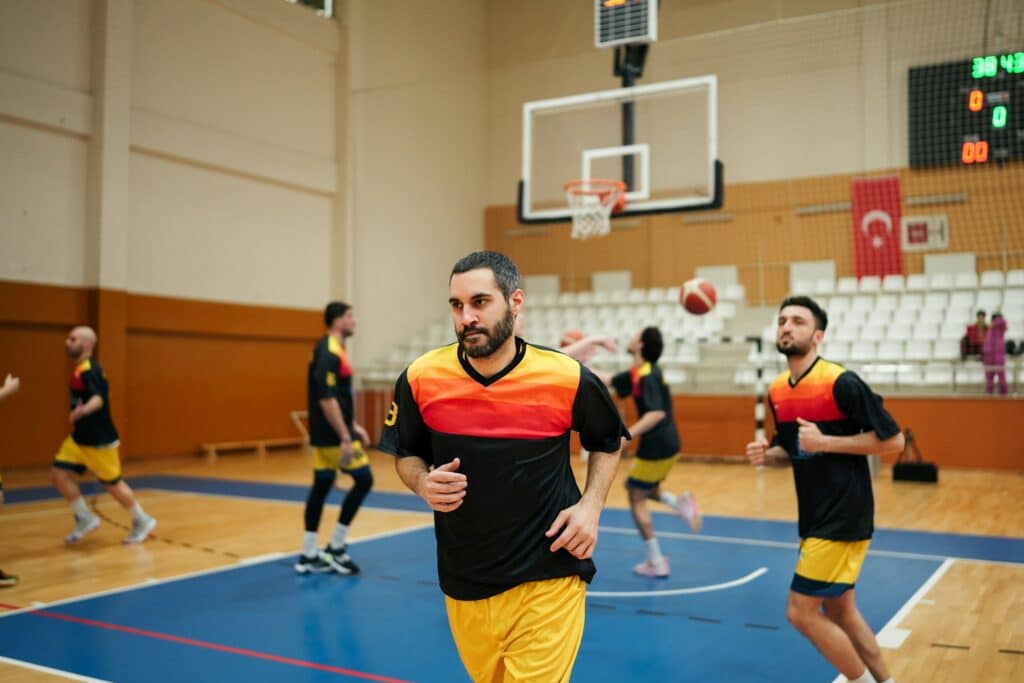
Developing a System for Game-Time Adjustments: Making the Right Adjustments Midgame
In the fast-paced world of basketball, the ability to make effective game-time adjustments is crucial for a coach’s success. The dynamic nature of the game means that strategies that worked in the first half may become ineffective in the second.
Developing a system for making these adjustments can be the difference between victory and defeat. This article outlines strategies for creating a system that allows you to adapt to the flow of the game, respond to opponents’ tactics, and optimize your team’s performance during crucial moments.

1. Establish Clear Game-Time Adjustment Principles
Before implementing a system for game-time adjustments, it’s important to establish clear principles that guide your decision-making process.
Flexibility
Emphasizing Adaptability
Flexibility is a cornerstone of effective coaching. Coaches must cultivate a mindset that embraces change. This begins with recognizing that each game presents unique challenges that may not align with the pre-planned strategy. Therefore, maintaining a flexible approach allows coaches to pivot quickly when necessary.
For example, if a key player gets into foul trouble early in the game, the coach may need to adjust not only player rotations but also overall strategy to accommodate a new lineup.
This could involve changing offensive plays to leverage the strengths of bench players or shifting defensive strategies to compensate for a lack of size or skill.
Anticipating Change
Coaches should prepare for potential changes during the game, whether due to injuries, foul trouble, or opponent adjustments.
Developing a set of alternative strategies in advance enables quicker decision-making during critical moments. This preparation can include rehearsing various scenarios in practice, so players understand their roles in different game situations.
Situational Awareness
Understanding Game Context
Situational awareness involves a thorough understanding of the current game context—score margins, time remaining, and player fatigue levels. Coaches need to keep track of the game’s flow and recognize when adjustments are necessary.
For example, if the team is trailing late in the game, it may require more aggressive offensive tactics, such as pressing the defense or employing a quick-paced attack. Conversely, if leading, the focus may shift to ball control and reducing turnovers to protect the lead.
Utilizing Analytics
Incorporating analytics can further enhance situational awareness. By analyzing statistical trends, coaches can make informed decisions about when to adjust strategies.
For instance, if a particular player consistently struggles against a specific defensive alignment, a coach might choose to adjust their coverage based on this insight.
Player Input
Encouraging Open Communication
Incorporating feedback from players is crucial for making effective adjustments. Coaches should create an environment where players feel comfortable sharing their observations and suggestions.
This collaborative approach fosters a sense of ownership among players and enhances their engagement.
During timeouts and breaks, coaches can ask players what they are experiencing on the court. Questions like “What are you seeing from their defense?” or “How can we exploit their weaknesses?” prompt valuable discussions that can lead to insightful adjustments.
Empowering Players
Empowering players to contribute to the decision-making process can also enhance their confidence and performance.
When players feel their input is valued, they are more likely to take ownership of their roles and perform at a higher level.

2. Analyze Opponent’s Patterns and Tendencies
Understanding your opponent’s patterns and tendencies is key to making effective adjustments.
Pre-Game Scouting
Gathering Intelligence
Before the game, coaches should gather as much intelligence as possible about the opposing team. This includes studying scouting reports, analyzing video footage, and reviewing past performances.
Coaches should pay close attention to the opponent’s offensive and defensive structures, identifying their go-to plays and strategies.
Identifying Weaknesses
Effective pre-game scouting also involves identifying potential weaknesses in the opponent’s game. For example, if an opposing team struggles with defending against pick-and-roll plays, coaches can emphasize this tactic during their offensive strategy.
In-Game Observations
Continuous Monitoring
During the game, continuous monitoring of the opponent’s behavior is essential. Coaches should observe how the opponent responds to various situations, including how they adjust to the strategies your team employs.
Adapting in Real Time
If the opponent shifts their defense, such as moving from man-to-man to a zone, coaches must be prepared to counter this change.
This might involve changing offensive formations or plays to exploit the gaps in the zone defense. Real-time adjustments are often the most effective way to capitalize on an opponent’s weaknesses.
Adapt Strategies
Implementing Countermeasures
Once a coach identifies the opponent’s patterns and tendencies, it’s essential to implement countermeasures promptly. This could involve altering defensive matchups or switching offensive sets to create mismatches.
For instance, if an opponent’s leading scorer is being guarded effectively by one of your defenders, consider switching the matchup to free up that player for better scoring opportunities. Alternatively, if a player is hot from the three-point line, you might want to run plays specifically designed to get them open looks.

3. Develop a Repertoire of Adjustments
Having a repertoire of adjustments ready allows you to respond to various scenarios effectively.
Defensive Adjustments
Creating Multiple Schemes
Coaches should prepare different defensive schemes tailored to various game situations. For instance, you might plan to switch from man-to-man defense to a zone if you find your team struggling against a particularly strong offensive lineup.
Alternatively, employing a full-court press can disrupt an opponent’s rhythm and create turnovers.
Responding to Opponent Tactics
Defensive adjustments can also be made based on the specific tactics employed by the opponent. If they are consistently driving to the basket, a coach might choose to emphasize help defense or increase the physicality of the defensive play.
Offensive Adjustments
Diverse Offensive Strategies
Develop alternative offensive strategies to keep the opponent guessing. This can include changing the pace of play—slowing down the game to control possessions or speeding it up to exploit mismatches.
Coaches should also have specific plays ready that exploit the weaknesses identified during the pre-game scouting process.
Situational Plays
Creating situational plays for late-game scenarios, such as out-of-bounds plays or last-second shots, is critical. These plays should be rehearsed regularly in practice to ensure players are comfortable executing them under pressure.
Special Situations
End-of-Game Strategies
Design adjustments for special situations, such as end-of-game scenarios or dealing with foul trouble. Coaches should have pre-planned strategies for these critical moments, allowing them to react quickly and effectively.
Handling Foul Trouble
If a key player is in foul trouble, coaches should have a strategy for managing their minutes while still being competitive. This may involve utilizing a deeper bench or adjusting the offensive and defensive schemes to minimize the impact of the player’s absence.

4. Communicate Adjustments Effectively
Once the need for adjustments is identified, effective communication is essential for implementation.
Clear and Concise Messaging
Utilizing Timeouts
Timeouts provide an excellent opportunity to communicate adjustments to the team. Coaches should ensure that messages are clear and concise, focusing on key points that players can easily remember and implement.
Visual Aids
Using visual aids, such as whiteboards or digital displays, can help convey complex adjustments quickly. Visual representations of plays can reinforce verbal instructions and ensure that all players are on the same page.
Reinforce During Gameplay
On-Court Communication
Encourage players to communicate on the court, reinforcing the adjustments made during timeouts. This includes calling out plays, providing feedback, and ensuring that everyone is aware of their roles and responsibilities.
Encouraging Leadership
Foster leadership within the team so that players can help communicate adjustments among themselves. Leaders should be empowered to direct their teammates and ensure that everyone is following the coach’s game plan.
Review and Reflect
Post-Game Analysis
After the game, conduct a review of the adjustments made and their effectiveness. Discuss what worked, what didn’t, and how the team can improve in future games. This reflective practice can lead to better decision-making and adjustments in subsequent games.
Player Feedback
Encourage players to provide feedback on the adjustments made during the game. Their perspectives can offer valuable insights into how well the adjustments were received and implemented.
Developing a System for Game-Time Adjustments Conclusion:
Developing a system for game-time adjustments is vital for any basketball coach aiming for success. By establishing clear principles, analyzing opponent patterns, building a repertoire of adjustments, and communicating effectively, coaches can significantly enhance their team’s ability to respond to in-game challenges. This flexibility and preparedness can lead to improved performance, greater player confidence, and, ultimately, more victories on the court. Embrace the complexities of the game, and let your adaptability be a key driver of your coaching success.



